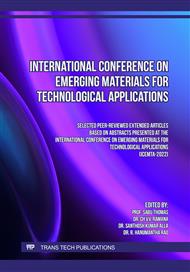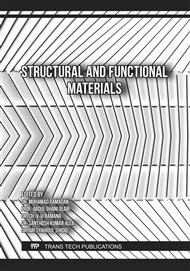[1]
S.A.E. Johansson, J.L. Campbell, K.G. Malmqvist. 1996. Particle-Induced X-Ray Emission Spectrometry (PIXE) Edited by. Wiley & Sons: New York. J. Am. Chem. Soc., 118, 27 (1996), 6528–6529.
DOI: 10.1021/ja955314e
Google Scholar
[2]
K.Ishii, PIXE and its Applications to Elemental Analysis. Quantum Beam Sci., 3(2)(2019),1-14.
Google Scholar
[3]
K.M. Varier, Daisy Joseph, G.J. Naga Raju, P. Sarita, K.B. Dasari Particle Induced X-ray Emission: Principle and Applications, Ion Beam Analysis for Materials Characterization IANCAS Bulletin, Volume: XVI, No.1, 2021.
Google Scholar
[4]
A.V.S. Satyanarayana, M. Jagannadha Rao, T.V.S.P.V.S. Guru, Proton Microprobe Analysis with 3 MeV and Si (Li) Detector at Z<17 Elements in Charnockite Composition May Materials Today: Proceedings 66(3), (2022) 1365-1368.
DOI: 10.1016/j.matpr.2022.05.212
Google Scholar
[5]
C.W. Graham, C.R. John, L. C. John, N. Zdenek, & J. T. William, Application of PIXE to mineral characterization. Nuclear instruments and methods in physics research B; Beam Interactions with Materials and Atoms. Vol. 189, (2002) pp.387-393.
DOI: 10.1016/s0168-583x(01)01095-3
Google Scholar
[6]
A. Sriramadas and A.T. Rao, Charnockites of Visakhapatnam, Andhra Pradesh. Journal of Geological Society of India, 20, (1979) 512-517.
Google Scholar
[7]
A.V.S. Satyanarayana, S. Ravi Kumar, Geochemical analysis of minerals from Charnockite Hill, Visakhapatnam, Andhra Pradesh, India. Indian Journal of Geosciences, 71 (2) (2017), 435–438.
Google Scholar
[8]
M. H. Christopher, J. L. Campbell, G. K. Czamanske, Refinement of major, minor element PIXE analysis of rocks and mineral. Nucl. Instrum. Meth. Phys. Res. Sect. B: Beam Interact. Mater. Atoms, 366 (2016), 40-50.
DOI: 10.1016/j.nimb.2015.10.018
Google Scholar
[9]
J.A. Maxwell, W.J. Teesdale, J. L. Campbell, The Guelph PIXE software package II. Nuclear Instruments and Methods in Physics Research B: Beam Interactions with Materials and Atoms, 95 (1995): 407-421.
DOI: 10.1016/0168-583x(94)00540-0
Google Scholar
[10]
J.L. Campbell, N.I. Boyda, N. Grassi, P. Bonnick, J. A. Maxwell, 2010. The Guelph PIXE software package IV, Nucl. Instrum. Methods B. 268 (2010), 3356-3363.
DOI: 10.1016/j.nimb.2010.07.012
Google Scholar
[11]
A.V.S. Satyanarayana, S. Ravi Kumar & S.V.R.A.N. Sharma, An application of PIXE technique to Proto Crustal Rocks: Geo chemical Evaluation of Granulitic Charnockites of Eastern Ghats, Andhra Pradesh, India. J. Nucl. Phys. Mat. Sci. Rad. A. 3 (2016), 147-155
DOI: 10.15415/jnp.2016.32016
Google Scholar
[12]
A.V.S. Satyanarayana, S. Ravi Kumar, Geochemical analysis of minerals from Charnockite Hill, Visakhapatnam, Andhra Pradesh, India. Indian Journal of Geosciences, 71 (2) (2017), 435–438.
Google Scholar
[13]
A.T. Rao J.U. Rao J U, and Y. Masaru, Geochemistry and Tectonic Evolution of the Pyroxene Granulites from Visakhapatnam Area in the Eastern Ghats Granulite Belt, India Journal of Geosciences, Osaka City University, 36 (7) (1993), 135-150.
Google Scholar
[14]
A.T. Rao, and V.R.R.M. Babu, Allanite in Charnockites rock airport hill near Visakhapatnam, Andhra Pradesh. American Mineralogist, 63 (1978), 330-331.
Google Scholar
[15]
D.C. Kamineni, M. Bandari, A.T. Rao. Halogen-bearing minerals from Airport Hill, Visakhapatnam, India. American Mineralogist, 67 (1982),1001-l004.
Google Scholar
[16]
https://xdb.lbl.gov/Section1/Table_1-2.pdf
Google Scholar
[17]
A.V.S. Satyanarayana, M. Jagannadharao, K. Chandra Mouli, B. Seetarami Reddy. The Performance of PIXE Technique through a Geochemical Analysis of High-Grade Rocks. J. Nucl. Phy. Mat. Sci. Rad. A., 7(1) (2019), 13-28.
DOI: 10.15415/jnp.2019.71002
Google Scholar
[18]
David D. Cohen, Particle Induced X-ray Emission, Australian Nuclear Science and Technology Organization Lucas Heights Research Laboratories ANTSO-697 (1991) file:///C:/Users/saitr/OneDrive/Desktop/EP103979.pdf
Google Scholar
[19]
M.H. Norman, L.C. John, and J.T. William. PIXE analysis in mineralogy and geochemistry. The Canadian Mineralogist, 33 (1995), 293-302.
Google Scholar
[20]
Chris G. Ryan, PIXE and the nuclear microprobe: Tools for quantitative imaging of complex natural materials. International Conf. on Nuclear Microprobe Technology and Applications, Leipzig, (2010), Submitted to Nucl. Instr. Meth. B.
Google Scholar



